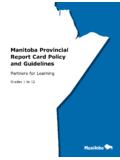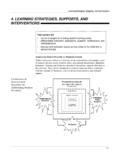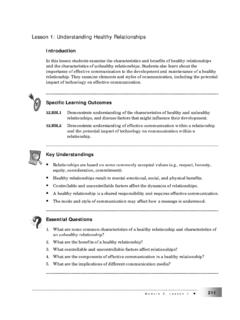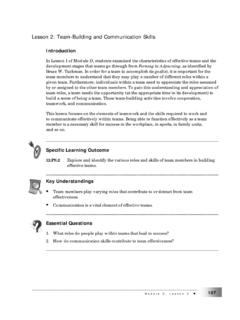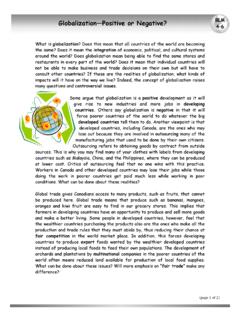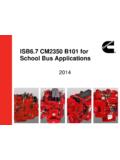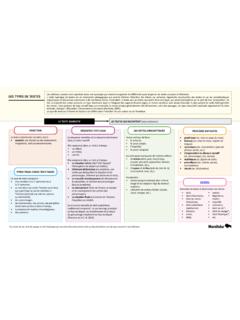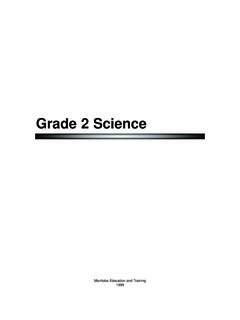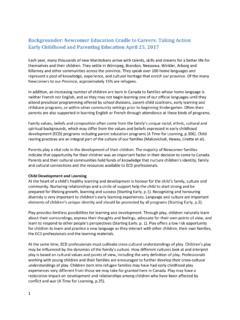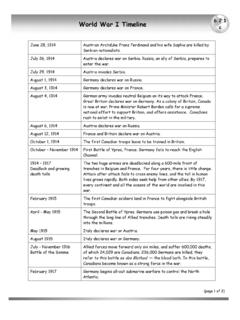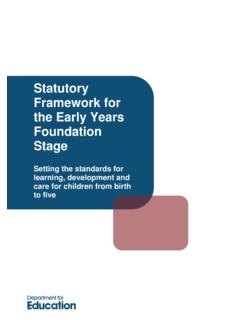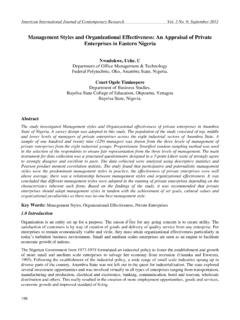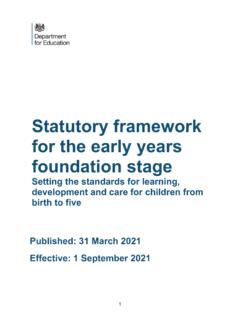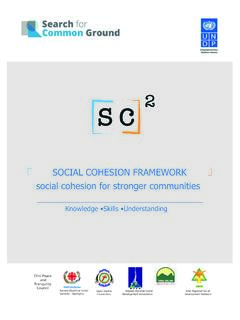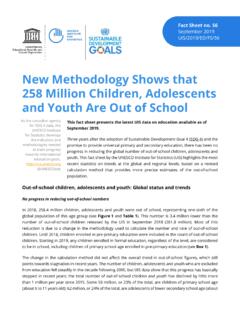Transcription of English Language Arts Curriculum Framework
1 English Language arts Curriculum FrameworkA Living DocumentSeptember 20202020 Manitoba EducationEnglish Language arts Curriculum FrameworkA Living DocumentSeptember 2020 This Framework is designed to be understood as a living document. Because of the participatory nature of the development process, content continues to be validated, developed, and refined based on observations and feedback from sustained deeper learning cohorts and groups, in collaboration with university faculty of education partners, and in consultation with other Language arts Curriculum Framework : a living documentIncludes bibliographical references. Copyright 2020, the Government of Manitoba, represented by the Minister of Education. Manitoba Education Winnipeg, Manitoba, CanadaEvery effort has been made to acknowledge original sources and to comply with copyright law. If cases are identified where this has not been done, please notify Manitoba Education.
2 Errors or omissions will be corrected in a future edition. Sincere thanks to the authors, artists, and publishers who allowed their original material to be used. All images found in this resource are copyright protected and should not be extracted, accessed, or reproduced for any purpose other than for their intended educational use in this websites referenced in this resource are subject to change without notice. Educators are advised to preview and evaluate websites and online resources before recommending them for student resource is available on the Manitoba Education website at Websites are subject to change without the department is committed to making its publications as accessible as possible, some parts of this document are not fully accessible at this in alternate formats upon vIntroduction 1 Purpose 1 Background 1 Foundations and Principles 5 What Is English Language arts ?
3 5 Relationship between English Language arts and Literacy 5 Guiding Principles 6 Powerful Practice in English Language arts 18 The English Language arts Learning Landscape 21 English Language arts Goals 21 What Grounds the Design of the ELA Curriculum ? 22 The English Language arts Conceptual Framework 22 Competency, Communities, and Meaningful Contexts 23 Effective English Language arts Planning, Teaching, and Learning 27 Assessment As, For, and Of Learning 34 English Language arts Practices 37 What is the Structure of the ELA Curriculum ? 44 Structural Design of the English Language arts Curriculum 45 Planning Effectively for English Language arts 47 Planning for Rich, Meaningful Learning Experiences and Deeper Understanding 47 Using Lenses to Plan Rich, Meaningful Learning Experiences 49 Using Lenses to Focus and Deepen Learning Experiences 51 Approaches to Instructional Design 53 Embedding and Connecting Programmatic Structures in Rich Learning Experiences 54 Grade Bands, Learning Growth, and Dimensions of Learning 57 Enacting the Practices and Dimensions of Learning Growth: Independence, Breadth, Depth, and Transformation 57 Interrelated Dimensions of Learning Growth 59 English Language arts Curriculum Framework .
4 A Living DocumentivGrade Band Descriptors 65 Enacting the Four ELA Practices in the K to 2 Grade Band 66 Enacting the Four ELA Practices in the 3 to 5 Grade Band 67 Enacting the Four ELA Practices in the 6 to 8 Grade Band 68 Appendix: Elaborations 69 Language as Sense Making: Kindergarten to Grade 2 69 Language as System: Kindergarten to Grade 2 72 Language as Exploration and Design: Kindergarten to Grade 2 74 Language as Power and Agency: Kindergarten to Grade 2 76 Language as Sense Making: Grades 3 to 5 79 Language as System: Grades 3 to 5 81 Language as Exploration and Design: Grades 3 to 5 84 Language as Power and Agency: Grades 3 to 5 86 Language as Sense Making: Grades 6 to 8 88 Language as System: Grades 6 to 8 91 Language as Exploration and Design: Grades 6 to 8 93 Language as Power and Agency: Grades 6 to 8 95 References 99 AcknowledgementsvAcknowledgements Manitoba Education gratefully acknowledges the contributions of the following individuals and groups in the development of the English Language arts Curriculum Framework : A Living Document.
5 Because of the participatory nature of the development process, content continues to be tested, revised, and developed based on observations and feedback from sustained deeper learning cohorts, in collaboration with education faculty members, and in consultation with other stakeholders. Development and Implementation Co-leadersAngela Burdett (from september 2017)Karen Boyd (until August 2014)Lisa Goolcharan (from January 2019)Shelley Warkentin (until January 2019)Critical Friends, Contributors, ReviewersKaren Boyd (from september 2014) River East Transcona School DivisionMichelle Honeyford University of ManitobaMarlene McKay Independent ConsultantWayne Serebrin University of ManitobaShelley Warkentin (from January 2019) Seven Oaks School DivisionInitial Working GroupBrandi Bartok Pembina Trails School DivisionJonine Bergen St. Paul s High SchoolAngela Burdett Frontier School DivisionSusan Hayward Lakeshore School Division (until 2015) and Independent (from 2015)Jessica Kowall Child Guidance Clinic, Winnipeg School Division (until 2015)Steve Lawrie Louis Riel School Division (until 2015)Elaine Levesque Division scolaire franco-manitobaineSara MacPherson Manitoba Education and TrainingRuth McDonald Pembina Trails School DivisionVirginia Moose Mystery Lake School DivisionGeorgette Nairn River East Transcona School DivisionCathy Oresnik Pembina Trails School DivisionJodianna Paterson Child Guidance Clinic, Winnipeg School Division (from 2015)
6 Mark Reimer Hanover School DivisionWayne Serebrin University of ManitobaChris Wigglesworth Seven Oaks School Division Karen Wiebe Manitoba Teachers SocietyInitial Grade Band Exploration Group Jen Anderson Brandon School DivisionElizabeth Bourbonniere River East Transcona School DivisionAngela Burdett Frontier School DivisionMike Chopek Frontier School Division English Language arts Curriculum Framework : A Living DocumentviCathy-Jane Green Brandon School Division Michelle Honeyford University of Manitoba Heather Khan St. James-Assiniboia School Division Jennifer Kolesar Prairie Spirit School Division Claudette Laurie Bureau de l ducation fran aise Elaine Levesque Division scolaire franco-manitobaineRuth McDonald Pembina Trails School Division Janice Matthewman St. James-Assiniboia School DivisionRenee McGurry St. James-Assiniboia School Division Jennifer McKinnon Louis Riel School DivisionGeorgette Nairn River East Transcona School DivisionMark Reimer Hanover School DivisionMonica Reis Rolling River School DivisionMichelle Vermette Seven Oaks School DivisionChris Wigglesworth Seven Oaks School Division Andrea Zaroda River East Transcona School Division Pilot Cohort (June 2015 to June 2017)Frontier School DivisionMountain View School DivisionRiver East Transcona School DivisionSt.
7 James-Assiniboia School DivisionSeine River School Division (until June 2016)Targeted Development Team Joan Badger St. James-Assiniboia School Division Kelsey Black Mountain View School DivisionAngela Burdett Frontier School DivisionStacey Cook Mountain View School DivisionSuzanne Cottyn Mountain View School DivisionWendy Gautier Frontier School DivisionStacey Hassel Mountain View School DivisionCharlene Helgeson Mountain View School Division Kelly May River East Transcona School DivisionTara McLaughlin St. James-Assiniboia School DivisionDarlene Michalot-Dumas Frontier School Division Louisa Petznick Frontier School Division Nicole Staniforth Seine River School DivisionAndrea Zaroda River East Transcona School Division Sustained Deeper Learning Cohorts (June 2017 to April 2019):South Central CohortBorder Land School Division Garden Valley School Division Pine Creek School Division Portage la Prairie School Division Prairie Rose School DivisionPrairie Spirit School DivisionRed River Valley School DivisionWestern School DivisionAcknowledgementsviiProvincial CohortHanover School DivisionMystery Lake School DivisionPark West School DivisionPembina Trails School DivisionWinnipeg School Division (until June 2019)Northwest CohortFlin Flon School Division Kelsey School DivisionSwan Valley School Division Seven Oaks School Division CohortSouthwest CohortFort la Bosse School DivisionRolling River School DivisionSouthwest Horizon School DivisionTurtle Mountain School DivisionTurtle River School DivisionWinnipeg School Division CohortManitoba Education StaffCarole Bilyk Coordinator (until August 2016)
8 Louise Boissonneault CoordinatorKaren Boyd Project Co-leader/Consultant (until August 2014)Angela Burdett Project Co-leader/Consultant (from september 2017)Wenda Dickens Coordinator (until April 2018)Darryl Gervais Director (until February 2019)Lisa Goolcharan Project Co-leader/Consultant (from January 2019)Kristin Grapentine Desktop PublisherVictoria McMahon Project Co-leader/Consultant ( september 2019)Development Unit Instruction, Curriculum and Assessment BranchDocument Production Services Unit Inclusion Support BranchDevelopment Unit Instruction, Curriculum and Assessment Branch Early Childhood and Development Unit Instruction, Curriculum and Assessment Branch Early Childhood and Development Unit Instruction, Curriculum and Assessment BranchInstruction, Curriculum and Assessment Branch Early Childhood and Development Unit Instruction, Curriculum and Assessment Branch Document Production Services Unit Inclusion Support BranchEarly Childhood and Development Unit Instruction, Curriculum and Assessment Branch English Language arts Curriculum Framework .
9 A Living DocumentviiiMarjorie Poor Publications EditorD i a n a Tu r n e r Acting Coordinator (from April 2018)Shelley Warkentin Project Co-leader/Consultant (until January 2019)Document Production Services Unit Inclusion Support BranchEarly Childhood and Development Unit Instruction, Curriculum and Assessment BranchEarly Childhood and Development Unit Instruction, Curriculum and Assessment BranchIntroduction1 IntroductionPurposeThe purposes of English Language arts Curriculum Framework : A Living Document are to support, nurture, and inspire the learning growth of all learners provide direction for learning design and assessment set out the philosophical and pedagogical foundations for English Language arts learning present the four English Language arts practices and their characterizing elements describe multiple ways that students engage in practices at various points in learning encourage educators and learners to engage in vital, rigorous, and venturous forms of pedagogy (Jardine and Friesen 4)BackgroundIn January 2011, the Western and Northern Canadian Protocol for Collaboration in Education, Kindergarten to Grade 12 (WNCP) prepared Guiding Principles for WNCP Curriculum Framework Projects in response to the significant changes in the ways people live and work in today s world.
10 In July 2011, the report Implications of the OECD s Programme for International Student Assessment (PISA) for Curriculum , Instruction, and Professional Learning in Manitoba (and Canada) (Manitoba Education) was developed for Manitoba to provide an analysis of English Language arts (ELA) Curriculum , approaches to professional learning, and assessment practices across January 2012, Manitoba engaged focus groups of Manitoba educators in order to hear observations, insights, and feedback related to ELA Curriculum , supports, resources, and assessment. A report for WNCP partners was published in March 2012: English Language arts in Canada and around the World: Renewal of the WNCP Framework and Associated Curricula Based upon Guiding Principles for WNCP Curriculum Framework Projects) (Western and Northern Canadian Protocol for Collaboration). In January 2013, Jardine and Friesen developed a follow-up document, Implementation Guide: Guiding Principles for WNCP Curriculum Framework Projects.
